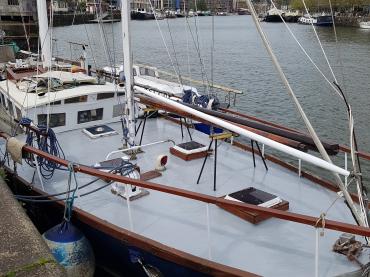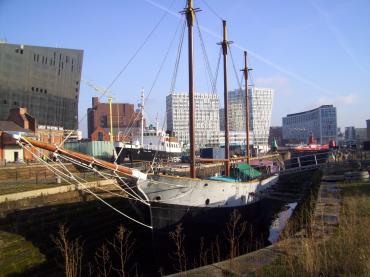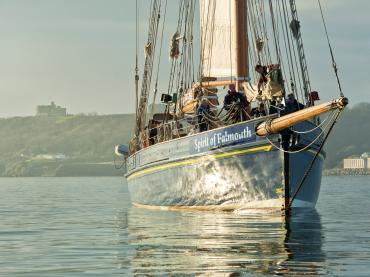Previous names
- 1900 - 1908 Lizzie May
Details
Construction
Dimensions
History
KATHLEEN & MAY was built for leading shipowner Captain John Coppack and named after his daughters Lizzie and May. She was employed taking cargoes such as cement, coal, pitch and clay anywhere between Oban, Scotland and the Channel Islands. Her fo'c'sle could house four hands, while the Captain and mate occupied small cabins leading off the saloon, which also served as a mess room.
Her first commercial voyage was under Captain Tom Hughes from Connah's Quay to Rochester with 226 tons of firebricks. She then carried cement to Plymouth, pitch to Cardiff, coal to Falmouth and clay to Weston Point. In her first 8 years, she sailed nearly 40,000 miles, carrying various cargoes of over 24,000 tons.
In 1908, she was purchased by M J Fleming of Youghal in Southern Ireland, renamed KATHLEEN & MAY after his daughters, and placed in the coal trade between the Bristol Channel and Ireland, carrying oats or pit props on the return passages. Under Captain Joe Aherne of Youghal she imported coal from Lydney and from Garston, often carrying oats or pit props on the outward voyage.
On St George's Day 1931, she carried her last cargo under sail alone - 202 tons of coal from Cardiff. In that year, she was purchased by Captain Jewell, fitted with an 80HP auxiliary engine and her topmasts were shortened. Captain Jewell died in 1945 and KATHLEEN & MAY was left to his son Tommy who continued to operate her until 1961, after which she had a series of owners until she finally retired in 1967.
During 1968, KATHLEEN & MAY was discovered in bad repair by the Duke of Edinburgh who created the Maritime Trust in London to help preserve her. She was bought by them in 1970 with funds given by the Hong Kong shipowner Sir Yue-Kong Pao. They began restoring her as a typical West Country schooner.
In 1998, she was sold for £80,000, towed to Bideford and moored at a disused coal wharf where restoration work began. She has now undergone a complete restoration to full sailing condition back to her original 1900 build, with the exception of some up to date conveniences like heads and a 400 hp engine. She has subsequently sailed across the Irish Sea and the Bristol Channel several times and has attended festivals in Dublin, Bristol, Derry and her old home port of Youghal. For example, In 2008, she was chartered by Companie de Transport Maritime a la Voile to carry 30,000 bottles of French wine to Dublin. She has crossed the Bay of Biscay to Bilbao where she was the paid guest of the famous Guggenheim museum for three weeks and, following a £2m refit, she set sail from Bideford to attend various maritime festivals during the summer of 2011.
Watch an archive video featuring KATHLEEN & MAY making a delivery of milk nuts, believed to be her last ever working trip, here
Moved from Liverpool to Gloucester Docks June 2021 for maintenance works at T Nielsen & Co Ltd
This vessel is a survivor from the First World War. You can read more about her wartime history by visiting our First World War: Britain's Surviving Vessels website www.ww1britainssurvivingvessels.org.uk.
Significance
1. What is the vessel’s ability to demonstrate history in her physical fabric?
Evidence for designs, functions, techniques, processes, styles, customs and habits or uses and associations in relation to events and people. How early, intact or rare these features are may impact on significance.
As the UK’s last working wooden hulled three-masted topsail schooner and the only one of this construction still in operation, KATHLEEN & MAY typifies the great era of the British merchant schooner with a rig that was widely adopted from the 1870s to the First World War due to its efficient and economical form. Both rig and hull were crafted, and subsequently repaired and restored between 1999 and 2002, using traditional techniques developed over 400 years. At build, KATHLEEN & MAY incorporated the first known example of the Appledore roller reefing gear: this has been fully restored on all three booms for use today. She was fitted with an engine in 1931, her topmasts reduced in height and square topsails removed. Her current engine is a new Volvo Penta and generator installed in June 2015 by a local Merseyside company and, whilst her rig has been restored to its original specification, a sail is no longer carried on the crossed yard on the foremast which was used in the original square topsail configuration. During conservation approximately 85% of her planking and 60% of the frames were replaced and she was then re-decked. However, most of her internal timbers and fittings remain original. The captain’s quarters in the stern, comprising a saloon and comfortable sleeping cabin, have been sympathetically restored to show the high quality workmanship involved, reflecting the high social status of a master of such a vessel. A prayer from her early days - God save the Kathleen & May – can still be seen inscribed into the saloon panelling.
2. What are the vessel’s associational links for which there is no physical evidence?
Associations with people or places. Off-ship research.
KATHLEEN & MAY was built by the reputable wooden shipbuilders Ferguson and Baird at Connahs Quay on the R. Dee North Wales, and is now the last surviving Welsh-built merchant sailing vessel. She was commissioned by leading Chester ship-owner Captain John Coppack and originally named after his daughters Lizzie and May. She has strong regional significance from her working life which was spent in the home trade, sailing between Scotland, London, the Channel Islands and later between Cardiff, Ireland, Liverpool and the West Country, covering a wide geographical area and sailing nearly 40,000 miles in her first 8 years. Under Irish ownership and re-named KATHLEEN & MAY, she developed a strong significance for the port of Youghal and the Bristol Channel where she plied the coal trade. In this role, she is illustrative of the national efforts made to maintain the essential trade in basic materials during the First World War.
In 1969 the Duke of Edinburgh, who had been instrumental in the rescue and restoration of CUTTY SARK, started the Maritime Trust as a means of preserving other significant British ships, with KATHLEEN & MAY an early object of the Trust’s attention as a national icon. She was purchased by the Trust in 1970 with funds from the Hong Kong ship-owner Sir Yue-Kong Pao. After restoration work carried out by the Trust in Appledore and Mashford’s Yard, Cremyll, KATHLEEN & MAY was opened to the public in Sutton Harbour Plymouth from 1971 to 1978, when she was towed to St. Katherine Dock London to form part of the Historic Ship Collection until 1985 when the collection was dispersed.
Subsequently she was sold on, fell into disrepair, and was then bought in 1998 by a local business man who brought her back to Bideford, the port with which formerly she had been associated, and where she was conserved to full working order. Since then she has cruised the UK coast attending maritime festivals and visiting once more her home port of Youghal, where she was the subject of a documentary film. She has developed European links, being chartered by Companie de Transport Maritime a la Voile to carry 30,000 bottles of French wine to Dublin and also crossing the Bay of Biscay to Bilbao where she was the guest of the Guggenheim Museum for three weeks.
Records survive of the cargos she carried in her working days, along with a range of historic photographs and paintings, as well as log books from the First World War era. Although Bideford remains her home port, in 2011/12 she took up a berth in Albert Dock, Liverpool.
3. How does the vessel’s shape or form combine and contribute to her function?
Overall aesthetic impact of the vessel, her lines, material she was built from and her setting. Does she remain in her working environment?
KATHLEEN & MAY was substantially built to carry a cargo of 226 tons over a considerable distance around the UK coastline. Her planks were three inch pitch pine, laid on doubled oak frames and fastened with tree nails and iron bolts. She has an elegant semi-elliptical stern and a sailing rig of a kind first developed in Britain in the late eighteenth and early nineteenth centuries through North American connections. Her form made her fit for purpose, as well as being economical and a handsome vessel. Carrying as small a crew as possible was crucial to commercial success for modest sailing cargo vessels: the roller reefing gear fitted to the fore-and-aft sails on KATHLEEN & MAY was an important innovation in keeping crew numbers and costs to the minimum consistent with operating the ship to the highest achievable levels of performance. KATHLEEN & MAY remains in operational condition cruising the same waters she once traded; an appropriate setting which highlights her significance as one of the few historic sailing merchant ships from this coastline to have survived.
Source: NHS-UK team, 9 July 2015.
This statement was developed as part of the Heritage Lottery funded First World War project. http://www.ww1britainssurvivingvessels.org.uk/
Key dates
-
1900
Built by Ferguson & Baird of Connahs Quay and named LIZZIE MAY
-
1908
Sold and renamed KATHLEEN & MAY
-
1961
Laid up
-
1970
Bought by the Maritime Trust
-
1998
Bought by a private owner and restored at Bideford
-
2007
Awarded £1,829 and £2,305 grants by National Historic Ships
-
2009
Vessel put up for sale
-
2010
Awarded a project grant of £1,000 by National Historic Ships
Grants
-
January 2010
A project grant of £1000 for attendance at Bristol Festival was made from the Strategic Development Fund of National Historic Ships
-
March 2007
A grant of £1829 to cover the costs of new signage and £2305 to cover the costs of remedial work on the rigging was made from the Strategic Development Fund of National Historic Ships
Sources
Smith, Peter, Heritage of the Sea: Historic Ships in the British Isles
Brouwer, Norman J, International Register of Historic Ships, Anthony Nelson, Edition 2, 1993
Greenhill, Basil, Merchant Schooners, Volumes I & II, 1988
Sullivan, Dick, Old Ships, Boats and Maritime Museums, Coracle Books, 1978
Scott, Richard J, The Story of the Kathleen & May, The Maritime Trust
Green, Colin, Archive: The Kathleen & May, Edition 55, September 2007
Classic Boat: Tell Tales, pp8-9, February 1996
Classic Boat: 1,000 Boat Pageant - The Flotilla Boats, June 2012
Classic Boat: Duke of Edinburgh visits Kathleen & May in Devon, January 2003
Classic Boat: Kathleen & May to be sailed again, December 1999
Classic Boat: Tell Tales: Kathleen & May, March 1997
Classic Boat Trading Stories
Classic Boat: Congratulation to T Neilson, August 1996
Cadd, John, Classic Boat: I saw three ships come sailing in, pp42, April 2004
Simper, Robert, Maritime Heritage: Survivors of Coastal Sail, pp49-52, September - October Volume 2.3, 1998
Sea Breezes: Ships Preserved: 5. The Kathleen and May, pp19, February 1975
Own this vessel?
If you are the owner of this vessel and would like to provide more details or updated information, please contact info@nationalhistoricships.org.uk























